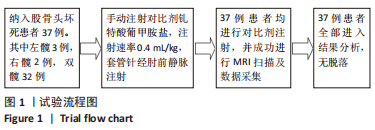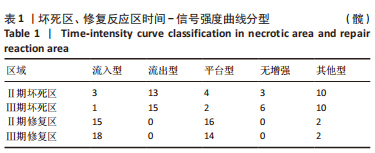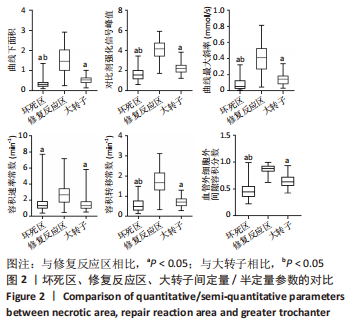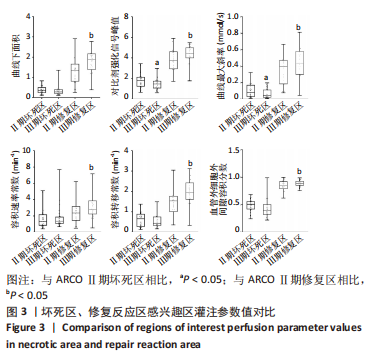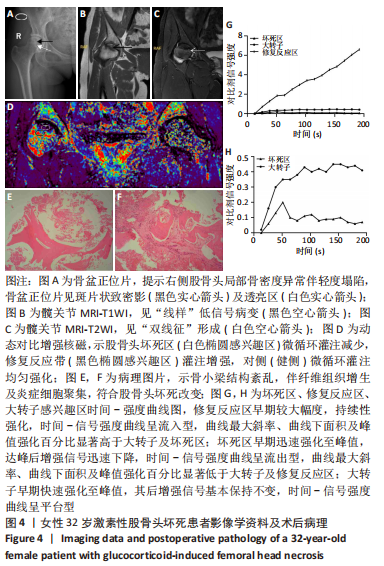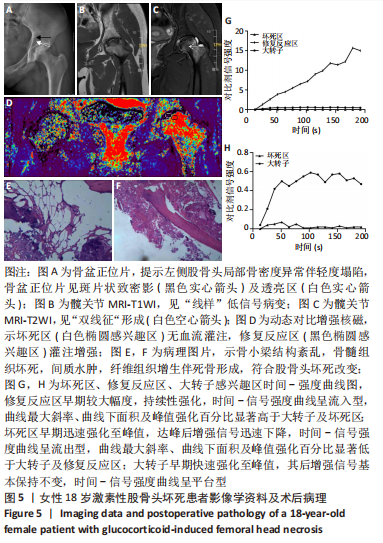中国组织工程研究 ›› 2023, Vol. 27 ›› Issue (36): 5864-5869.doi: 10.12307/2023.760
• 骨科植入物相关临床实践 Clinical practice of orthopedic implant • 上一篇 下一篇
动态对比增强核磁评价股骨头坏死微循环灌注的改变
环大维1,袁兆丰1,窦维强2,夏天卫1,邱 越1,张 超1,沈计荣1
- 1南京中医药大学附属医院,江苏省中医院骨伤科,江苏省南京市 210000;2通用电气医疗集团磁共振研究部,北京市 100000
Changes in microcirculatory perfusion of femoral head necrosis assessed by dynamic contrast-enhanced magnetic resonance imaging
Huan Dawei1, Yuan Zhaofeng1, Dou Weiqiang2, Xia Tianwei1, Qiu Yue1, Zhang Chao1, Shen Jirong1
- 1Department of Orthopedics and Traumatology, Jiangsu Provincial Hospital of Chinese Medicine, Affiliated Hospital of Nanjing University of Chinese Medicine, Nanjing 210000, Jiangsu Province, China; 2Magnetic Resonance Research Department of GE Medical Group, Beijing 100000, China
摘要:

文题释义:
动态对比增强核磁共振成像(dynamic contrast enhanced MRI,DCE-MRI):是评估血液循环灌注功能的一种敏感的非侵入性方法,其原理是在同一(或多个)放射平面上重复采集注射对比剂期间的图像并收集组织中的信号增强动力学,增强的时间动力学取决于局部循环系统、注射方式(注射速率、剂量、对比剂浓度)和对比剂类型。DCE-MRI成像的主要目的是研究毛细血管中的血液与血管外细胞外空间之间的交换功能。DCE-MRI有多种分析方式以获得视觉标准、半定量标准或微循环生理参数。在微循环生理参数方面,DCE-MRI使用Tofts药代动力学双室模型,其假设血流在血管内及血液与血管外细胞外空间进行交换,通过模型可将血流灌注情况进行量化,提取灌注相关参数,绘制时间-强度曲线图、计算半定量参数及定量参数,这些参数反映了灌注组织中的血管流入量、渗透性、毛细血管通透性、血管外细胞外间隙等情况。背景:目前股骨头坏死血运的临床观察多使用数字减影血管造影技术,通过观察对比剂的进出情况评估股骨头营养血管的通畅与否。数字减影血管造影虽然能直观观察到股骨头营养血管,但不能对灌注情况进行量化。另外,股骨头塌陷与否与疾病预后密切相关,但对于围塌陷期股骨头内血运变化的研究较少。
目的:比较股骨头坏死不同区域以及不同分期微循环灌注的差异,总结股骨头坏死微循环灌注特征改变,观察动态对比增强核磁在评估股骨头微循环灌注情况中的作用。
方法:回顾性收集2022-02-16/09-01于江苏省中医院就诊的股骨头坏死37例(69髋)患者的临床资料,其中男29例,女8例;年龄(35.35±12.19)岁(18-65岁)。采用动态对比增强核磁扫描患者双侧股骨头及股骨近端,扫描过程中静脉注射钆特酸葡胺,扫描完成后使用 Geniq软件进行数据后处理得到股骨头微循环灌注参数。在坏死区、修复反应区、大转子处绘制感兴趣区域,获得感兴趣区的时间-信号强度曲线并对其进行分类。使用配对t检验评估坏死区、修复反应区及大转子灌注参数之间的差异以及坏死不同分期股骨头灌注之间的差异;采用χ2检验评估坏死区、修复反应区及大转子时间-强度曲线分型的差异。
结果与结论:①对比不同区域的灌注参数,坏死区增强信号强度峰值、曲线下面积、最大斜率、容积转移常数、血管外细胞外间隙容积分数小于大转子,差异有显著性意义(P < 0.05),容积速率常数无明显差异(P > 0.05);②修复反应区信号峰值、曲线下面积、最大斜率、容积转移常数、速率转移常数、血管外细胞外间隙比值大于坏死区及大转子,差异有显著性意义(P < 0.05);③ARCOⅡ期坏死区信号峰值及最大斜率大于ARCOⅢ期,差异有显著性意义(P < 0.05);曲线下面积、速率转移常数、容积转移常数、血管外细胞外间隙比值对比无明显差异(P > 0.05);④ARCOⅡ期修复反应区信号峰值、曲线下面积、最大斜率、容积转移常数、速率转移常数、血管外细胞外间隙比值小于ARCOⅢ期,差异有显著性意义(P < 0.05);⑤提示股骨头坏死区微循环灌注速度、血流量及毛细血管渗透性显著降低,修复反应区微循环灌注速度、血流量及血管渗透性较正常区域显著提高,随着塌陷的发生,坏死区血流灌注速度及血流量进一步降低,修复反应区的灌注得到增强。
https://orcid.org/0000-0003-4338-3227 (环大维)
中国组织工程研究杂志出版内容重点:人工关节;骨植入物;脊柱;骨折;内固定;数字化骨科;组织工程
中图分类号:
